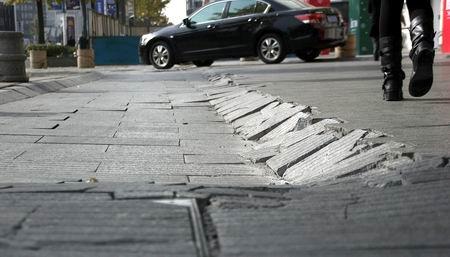
(Ecns.cn) – The threat of land subsidence has been discovered in over 50 cities in China, with three regions particularly affected, namely the Yangtze River Delta, North China and the Fenhe River-Weihe River basin area in Shaanxi and Shanxi provinces, according to a report from China Central Television (CCTV).
Excessive exploitation of underground water is claimed to be the main cause for ground level subsidence, and an increasing density of high-rise buildings in urban areas has also added to the impact.
To tackle the problem in a more systematic way, China's State Council approved the Land Subsidence Prevention Project on February 20, 2012, an endeavor revised by ten government ministries which demands that local governments improve their management systems of land stability and come up with more effective measures to prevent subsidence.
Cities under threat
On February 16, 2012, a Web user uploaded a set of photos to his microblog showing long fissures in the ground around the Shanghai Tower. In minutes, the photos were reposted thousands of times and immediately set off concerns about whether the surface cracks indicated a threat to public safety.
One of the fissures was about eight meters long and up to four centimeters wide at some points, while some of the cracks spread to adjacent flowerbeds and the sidewalk, according to China Daily.
Though the information office of the Shanghai municipal government assured residents that the base of the Shanghai Tower is solidly built, public concern about the issue of land subsidence has not abated, especially since media reports on the problem have continued to appear in recent years.
According to research, the total area of land in China that has sunk by more than 200 millimeters has reached 79,000 square kilometers.
Yet the populace hardly perceives this silent geological disaster, which is nevertheless potentially hazardous to infrastructure such as water and gas supply pipelines, architecture and railways.
Between 1921 and 1965, urban areas of Shanghai sank 1.69 meters, spurring the government to conduct research and take concrete measures to slow the rate of settling. If they had not done so, Shanghai might have been covered by seawater by the year 2000, according to the Shanghai Institute of Geological Survey.
Now, as part of the Land Subsidence Prevention Project, the State Council pointed out that there are more than 50 cities, including Beijing and Tianjin, that are seriously suffering from unwanted subsidence in Hebei Province, Shanxi Province, the Inner Mongolia Autonomous Region and others – and that the problem continues to spread.
Economic development to blame
With all the excitement about the economic growth in China, most people have ignored the impact of human behavior on the natural environment.
As demand for freshwater rises but water resources shrink, underground water has been over-extracted for decades, a major cause of land subsidence. Meanwhile, building skyscrapers in metropolises such as Shanghai, Beijing and Guangzhou has added fuel to the fire, rapidly hastening the decrease in land elevation.
For example, in the North China Plain, more than 2 million deepwater wells pump groundwater every day, even as statistics reveal a groundwater deficit of about 120 billion cubic meters, according to China Daily.
Since the 1970s, Cangzhou, a city in North China's Hebei Province, has experienced 2.4 meters of land subsidence. The problem has been so severe that an inpatient building of the Cangzhou People's Hospital, which was once a three-story building, was gradually reduced to two stories before being torn down and turned into a fountain.
Along with Cangzhou, other areas in the North China Plain such as Beijing and Tianjin are under threat of land subsidence caused by the overexploitation of groundwater. If the land subsidence continues to worsen, experts warn it may threaten the safety of the Beijing-Shanghai High-Speed Railway and the South-North Water Diversion Project.
In January, the downtown Hailun Road Station of Shanghai Metro Line 4 was closed for an emergency reinforcement after the occurrence of "uneven subsidence," and pit digging work for new buildings nearby was blamed for causing it, according to Shanghai Daily.
Usually, "uneven subsidence" takes place where there is construction work on buildings, which adds considerable weight to the base and leads to cracks and distortion.
National standards
As land subsidence creates trouble for residents and even endangers the existence of cities, the Land Subsidence Prevention Project aims to set up a system of national standards to ease the situation.
Local governments are now required to monitor underground water and land subsidence on a daily basis, and cooperate with other governments in the event of abnormal activity. For example, Shanghai has been cooperating with Jiangsu and Zhejiang Provinces to improve the efficiency of monitoring groundwater levels.
For the construction of skyscrapers, meticulous preparations are now required to ensure safer designs, and it is important to take foreseeable problems into consideration before construction in order to prevent problems caused by subsidence.

Copyright ©1999-2011 Chinanews.com. All rights reserved.
Reproduction in whole or in part without permission is prohibited.